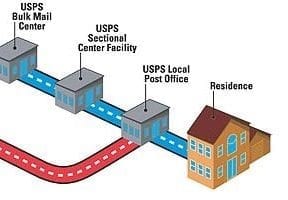Shipping costs are a primary reason for cart abandonment. But cost is not the only shipping issue that can harm your business. What happens after a customer makes a purchase is key to securing that customer’s return patronage. Fortunately, you can learn from many other etailers’ mistakes from this holiday season.
Here are my top three shipping mistakes to avoid.
3 Shipping Policies That Anger Customers
1. Failure to track down shipments. I belong to several professional online groups. One of the main questions this month were in regard to who is supposed to take responsibility when shipments are delayed or lost — the merchant or the customer?
This typically falls under one of two scenarios.
- Joe places an order and the tracking shows problems, such as an undeliverable address or other delays. Joe knows the address is correct, and contacts the seller. The seller directs Joe to contact the carrier to figure it out. Joe is frustrated because he believes it’s the seller’s job to make sure the package reaches his house.
- Joe places an order and the tracking shows it was delivered, but he never received the package. Joe contacts the seller and is told that there’s nothing the company can do because tracking shows delivery. Case closed.
While it’s true that a merchant has no control over what happens to a package once it’s picked up by the carrier, there are steps that can lead to a happier customer. They include the following.
- Look at the tracking details. Tracking reports show the exact time a package was delivered and, if applicable, who signed for the shipment. Take a moment so you can tell the customer exactly what happened.
- Dig deeper. If you have a carrier account, you likely have more pull in tracking down the exact issue. Online tracking reports typically only paraphrase the issue.
In the tracking report below, it appears that either the customer or the merchant sent the wrong address to UPS. After investigation, it was found that the label was torn during transit and the person who relabeled the package entered a typo on the street number.
Five days later, when it was on the truck for delivery, the driver reported that the street number was incorrect. The problem actually fell with UPS. Unfortunately, with this shipment, the merchant refused to get involved and by the time the customer was able to reach the right carrier agent, the package was already being returned to the originating address.
Take time to find out exactly what happened. Not all tracking reports convey what actually happened.
- Advising the customer to check family members or a neighbor. When a package shown as delivered is missing, it’s often because a family member or neighbor received it on the customer’s behalf and forgot to tell anyone.
2. Inflating shipping costs to cover insurance. Unless you sell high-dollar goods, inflating shipping costs to insure all packages can cause sticker shock during checkout. And offering the option for insurance can clutter the checkout process and actually cost you sales.
For some online stores, self-insuring via a policy that replaces or refunds customers when packages are lost, delayed, or damaged makes sense. When you consider the costs of insurance itself, and the time spent processing insurance claims, it can be a cheaper route.
A simple calculation can tell you if self insurance makes sense. For a given time period, take the total number of lost or damaged shipments and divide it by the total number of shipments. Multiply this by the average order value to see the average self-insurance cost per order.

A simple calculation tells you the average cost of self insurance per order.
Another option is to bypass the use of additional insurance with carriers and use a third-party service that covers every package. These services often cost pennies on the dollar compared to insurance costs of UPS, FedEx, and USPS — and provide a hassle-free claim process.
3. Making the customer wait for a replacement or reimbursement. When there is clearly a valid claim with the carrier, you should replace or refund the order as soon as you can, even if you’re waiting for reimbursement from the carrier. In the customer’s eyes, you’re tying up his money.
Merchant Is Responsible
Keep one key thing in mind: It’s the merchant that contracts with the carrier. This means any claims for reimbursement for lost shipments is filed by that merchant, not the customer. With that, it makes sense to do what most customers say should be the norm: help locate delayed and lost packages and be proactive about the process.
Avoid trying to lecture customers on how the carriers work. Customers already know it’s out of your hands until it reaches the destination. And they really don’t care. They just want what they paid for.





